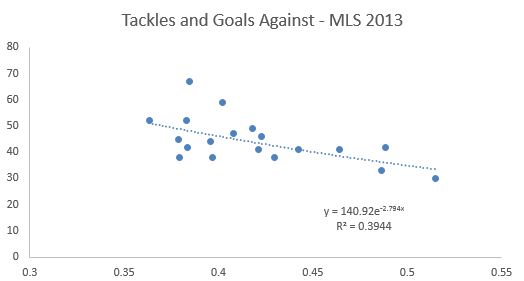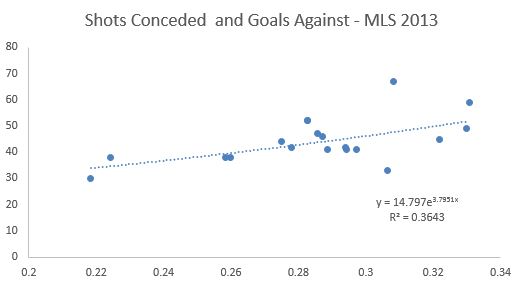Individual Defensive Statistics: Which Ones Matter and Top 10 MLS Defenders
/When a car breaks down, a mechanic's job is to tell you what caused the failure. He or she can generally pinpoint the problem to a specific part reaching the end of its useful life. But have you ever asked a mechanic why your car is working fine? Or which part deserves the most credit for your car running smoothly? Of course not. That would be a waste of everyone's time. There are many parts to a car and all are doing their job as designed. We never ask why when things are going well. The same dilemma exists in assessing soccer defenders. After all, most of how we assess defenders has to do with what goals were not scored. And when all the parts of the defenses are working as designed, goals are avoided. But which defenders deserve the credit when goals aren't scored? It's like the pointless car question, which parts of the car deserve the most credit when the car runs smoothly?
To even begin this conversation we need to take stock of what data exists for soccer defenders. And just to be clear, I am going to steer clear looking at a defender's offensive capability. I want to focus solely on defensive statistics. Whoscored is the only site that offers a collection of defensive statistics, and here is what they have and their definitions.
- Blocked Shot: Prevention by an outfield player of an opponents shot reaching the goal
- Clearance: Action by a defending player that temporarily removes the attacking threat on their goal/that effectively alleviates pressure on their goal
- Interception: Preventing an opponent's pass from reaching their teammates
- Offside Won: The last man to step up to catch an opponent in an offside position
- Tackle: Dispossessing an opponent, whether the tackling player comes away with the ball or not
These are the defensive-oriented statistics offered by Whoscored that are tracked at the individual player level. Of course, the other vital defensive statistic is shots conceded but those can't be attributed to any one player. So then, do any of these statistics matter? First there are a couple of assumptions to iron out.
A defender should be judged by the rate at which he accumulates statistics. So to get to that number we need to adjust these statistics to account for the time that the opponent has the ball. For example, Player A who averages 5 clearances per game might be better than Player B who averages 6 clearances if Player A's opposition had the ball 20% less often. That would mean player A made more clearances given the opportunities provided to him. So I will adjust all metrics by opposition possession.
Since I am trying to assess what goals are not scored, I going to look at the numbers at the team level first. It is only at the team level that goals can be attributed. After that analysis I will attempt to attribute value to the individual metrics.

Here are tackles per game per minute of opponent possession against goals scored. Tackles represents the strongest correlation of all the variables. In fact, tackles has a slightly stronger correlation to goals against than shots conceded. Here is a look at the shots conceded as a percent of opponent minute of possession.

The two points to the far left represent the LA Galaxy and Sporting Kansas City. They appear adept at limiting shots on goal per minute of opposition possession. They also stand out when looking at offsides won.
Rather than show every graph, here is a table of the defensive statistics, their level of impact and the R squared of the impact in predicting goals against.
Statistic
Goals Avoided per Unit
R squared
Clearances
-0.041
27.1%
Interceptions
-0.036
15.1%
Tackles
-0.077
39.4%
Offsides Won
-0.113
16.0%
Blocks % of Shots
-0.017
0.3%
Offsides won is the most impactful of the statistics (has the greatest slope) but there is a weaker correlation than Tackles or Clearances--in other words, there are greater deviations from the trend line. It's interesting to see that Blocks as a percent of shots has almost no impact on goals allowed.
This is interesting, but what to make of it all? In an ideal world we could compile these statistics into a meaningful metric in order to compare players. The most obvious way to do that statistically would be to run a multivariate regression using all of the statistics. The trouble with the result is that the statistics end up not being statistically significant predictors when mashed together. So developing a score from these metrics would be a bit of a fool's errand.
The other option would be to ignore the predictive strength of the variables and just use the goals avoided results as a scalar, multiply them by each player's statistics, add them up and compile a score. In this case the resulting score would be something we relate to as we could say that this player avoids x number of goals per game. However, this would give offsides won the statistic with the greatest importance despite the fact that the correlation is not strong.
To factor in the correlation we could leave the realm of sound statistical practice. We could multiply the goals avoided scalar by the R square. We could turn that into an index with the highest metric (tackles) equaling 1. If we did that here is the resulting table and values for each metric.
Statistic
Goals Avoided per Unit
R squared
GApU x R2
Index
Clearances
-0.041
27.1%
-0.011
0.37
Interceptions
-0.036
15.1%
-0.005
0.18
Tackles
-0.077
39.4%
-0.030
1.00
Offsides Won
-0.113
16.0%
-0.018
0.60
Blocks % of Shots
-0.017
0.3%
0.000
0.00
Tackles would be the most important statistic followed by offsides won and then clearances and interceptions. It turns out blocked shots have no material value in estimating goals against.
Before I use these numbers to reveal the top 10 MLS defenders, here are the caveats. Obviously this ranking is missing a few vital elements of defending in soccer. The first major omission is positioning. Often a defender being in the right position forces an offense to not make a pass that would increase their chance of scoring. There is no measurement for that but obviously a defender out of position is not a valuable defender. Clearances, interceptions, tackles and offsides won are clearing indicators that the player was probably in position to make the play and they indicate the player succeeding making the necessary play. But offensive attempts avoided are clearly missing.
The other major omission is the offensive play of the defender. A defender who defends well and represents an offensive threat is that much more valuable. But I'm not trying to solve for that here. I leave that for the subject of another post to integrate passing and offensive numbers to build a better score for defenders.
Here are the top 10 MLS defenders based on the score developed through the last week for players with a minimum of four appearances.
Rank
Name
Team
Tackles
Intercepts
Off Won
Clears
Defender Score
1
1.6
2.4
2
11.2
7.376
2
2.1
2.9
1.9
9.3
7.203
3
1.8
4.8
1.3
9.3
6.885
4
1.5
3.6
2.1
8.9
6.701
5
2.9
2.4
0.3
8.3
6.583
6
1.9
3.1
1.7
6.7
5.957
7
1.5
2.8
0.7
9.5
5.939
8
1.5
3.9
0.9
8.5
5.887
9
4
2.4
0.8
2.3
5.763
10
1.8
2.8
0.5
8.3
5.675
I find it comforting that, for a new metric, Jose' Goncalves, MLS Defender of the Year in 2013, tops the list. There's a big drop between the top 2 defenders and Paparatto. There's also another cliff after Andrew Farrell. But hey, it's a start.
I hope this was an enlightening ride through the mechanics of defending from a soccer perspective. The next time you're watching a game, don't just focus on the breakdowns. Also look for what makes the defense successful.

